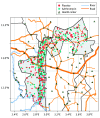Distance to Health Centers and Effectiveness of Azithromycin Mass Administration for Children in Niger: A Secondary Analysis of the MORDOR Cluster Randomized Trial
- PMID: 38100110
- PMCID: PMC10724761
- DOI: 10.1001/jamanetworkopen.2023.46840
Distance to Health Centers and Effectiveness of Azithromycin Mass Administration for Children in Niger: A Secondary Analysis of the MORDOR Cluster Randomized Trial
Abstract
Importance: The MORDOR (Macrolides Oraux pour Réduire les Décès avec un Oeil sur la Résistance) trial demonstrated that mass azithromycin administration reduced mortality by 18% among children aged 1 to 59 months in Niger. The identification of high-risk subgroups to target with this intervention could reduce the risk of antimicrobial resistance.
Objective: To evaluate whether distance to the nearest primary health center modifies the effect of azithromycin administration to children aged 1 to 59 months on child mortality.
Design, setting, and participants: The MORDOR cluster randomized trial was conducted from December 1, 2014, to July 31, 2017; this post hoc secondary analysis was conducted in 2023 among 594 clusters (communities or grappes) in the Boboye and Loga departments in Niger. All children aged 1 to 59 months in eligible communities were evaluated.
Interventions: Biannual (twice-yearly) administration of a single dose of oral azithromycin or matching placebo over 2 years.
Main outcomes and measures: A population-based census was used to monitor mortality and person-time at risk (trial primary outcome). Community distance to a primary health center was calculated as kilometers between the center of each community and the nearest health center. Negative binomial regression was used to evaluate the interaction between distance and the effect of azithromycin on the incidence of all-cause mortality among children aged 1 to 59 months.
Results: Between December 1, 2014, and July 31, 2017, a total of 594 communities were enrolled, with 76 092 children (mean [SD] age, 31 [2] months; 39 022 [51.3%] male) included at baseline, for a mean (SD) of 128 (91) children per community. Median (IQR) distance to the nearest primary health center was 5.0 (3.2-7.1) km. Over 2 years, 145 693 person-years at risk were monitored and 3615 deaths were recorded. Overall, mortality rates were 27.5 deaths (95% CI, 26.2-28.7 deaths) per 1000 person-years at risk in the placebo arm and 22.5 deaths (95% CI, 21.4-23.5 deaths) per 1000 person-years at risk in the azithromycin arm. For each kilometer increase in distance in the placebo arm, mortality increased by 5% (adjusted incidence rate ratio, 1.05; 95% CI, 1.03-1.07; P < .001). The effect of azithromycin on mortality varied significantly by distance (interaction P = .02). Mortality reduction with azithromycin compared with placebo was 0% at 0 km from the health center (95% CI, -19% to 17%), 4% at 1 km (95% CI, -12% to 17%), 16% at 5 km (95% CI, 7% to 23%), and 28% at 10 km (95% CI, 17% to 38%).
Conclusions and relevance: In this secondary analysis of a cluster randomized trial of mass azithromycin administration for child mortality, children younger than 5 years who lived farthest from health facilities appeared to benefit the most from azithromycin administration. These findings may help guide the allocation of resources to ensure that those with the least access to existing health resources are prioritized in program implementation.
Trial registration: ClinicalTrials.gov Identifier: NCT02047981.
Conflict of interest statement
Figures



Comment in
-
Unravelling the Potential Mortality Benefits of Mass Drug Administration With Azithromycin in Niger.JAMA Netw Open. 2023 Dec 1;6(12):e2346811. doi: 10.1001/jamanetworkopen.2023.46811. JAMA Netw Open. 2023. PMID: 38100114 No abstract available.
References
-
- Sharrow D, Hug L, You D, et al. ; UN Inter-Agency Group for Child Mortality Estimation and Its Technical Advisory Group . Global, regional, and national trends in under-5 mortality between 1990 and 2019 with scenario-based projections until 2030: a systematic analysis by the UN Inter-agency Group for Child Mortality Estimation. Lancet Glob Health. 2022;10(2):e195-e206. doi:10.1016/S2214-109X(21)00515-5 - DOI - PMC - PubMed
-
- GBD 2016 Mortality Collaborators . Global, regional, and national under-5 mortality, adult mortality, age-specific mortality, and life expectancy, 1970-2016: a systematic analysis for the Global Burden of Disease Study 2016. Lancet. 2017;390(10100):1084-1150. doi:10.1016/S0140-6736(17)31833-0 - DOI - PMC - PubMed
-
- United Nations Children’s Fund (UNICEF) . Niger: key demographic indicators. Accessed March 8, 2023. https://data.unicef.org/country/ner/
-
- United Nations. Transforming Our World: The 2030 Agenda for Sustainable Development. United Nations; 2015.
Publication types
MeSH terms
Substances
Associated data
LinkOut - more resources
Full Text Sources
Medical

